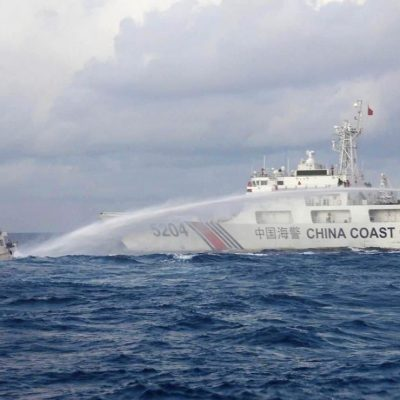
In the face of an unambiguous warning from the U.S. that if China launches an attack on the forces of the Philippines America will come to the aid of the Philippines, and left with no room for doubt that Manila and Washington are now united in their opposition to the maritime expansionism of China in the South China Sea, Beijing has now thought it prudent to disembark from its high horse and approach Manila to negotiate terms for peace.
Diplomatic circles have been taken by surprise that within days of Chinese troops launching on Filipino forces a murderous assault that smacks of an act of piracy rather than an offensive action by a disciplined army, Vice Foreign Minister of China Chen Xiaodong went to Manila early in July to find ways easing the escalating tension and avoiding a wider conflict that could involve the United States.
In this assault mounted in June, a Chinese coast guard vessel was guided deliberately to collide with a ship of the Philippines that had gone to deliver food, supplies and construction materials to forces of the Philippines lying grounded in the island of Second Thomas Shoal which is a territory of the Philippines illegally claimed by China. Since 1999, an ageing Filipino warship has been lying grounded at the Second Thomas Shoal; serving as the remote military outpost of Manila on the island.
Like common brigands, Chinese troops jumped on to the decks of two military boats of the Philippines that were accompanying the ship delivering supplies and attacked personnel of the Filipino navy with machetes, axes and hammers; damaging the boats. One Filipino navy personnel lost his thumb in the attack as the Chinese vessel rammed into the Filipino navy boat. The Chinese troops also looted a few rifles from the two boats. Anxious to prevent an escalation, the personnel of the Filipino navy tried to resist the Chinese attack with their bare hands.
The U.S. was not amused, however, with the unconventional action of the Chinese troops. The next day Washington renewed a warning that it was obliged to its close treaty ally the Philippines, describing the Chinese manoeuvre as “dangerous actions threatening regional peace and stability.” U.S. Deputy Secretary of State Kurt Campbell reaffirmed that the Mutua hil Defence Treaty of 1951 which obligated Washington and Manila to help defend each other in major conflicts extended to “armed attacks on Philippine armed forces, public vessels or aircraft, including those of its coast guard, anywhere in the South China Sea.”
President of the Philippines Ferdinand Marcos has made it clear that his country will not yield to “any foreign power,” while the Chief of the Armed Forces of the Philippines General Romeo Brawner has warned that his forces will fight back if assaulted again in the South China Sea. Gen Brawner has also asked China to pay the Philippines $1 million in damages for the two navy boats and return the seven rifles seized by the Chinese coast guard. The Filipino military may also ask China to pay for the planned surgery on the hand of the navy officer who had lost his right thumb.
Unlike the usual rhetoric to justify its high-handed behaviours against countries which China considers as weaker than itself, this time Beijing has approached Manila for negotiation. In the course of the visit of Vice Foreign Minister of China Chen Xiaodong to Manila, an agreement was signed between the two countries to improve communications during emergencies at sea. Both sides agreed to continue talks on enhancing ties between their coast guards. There was also another confidence-building plan to convene an academic forum among scientists and academics to improve marine scientific cooperation.
Foreign Undersecretary of the Philippines Theresa Lazaro has, however, made it clear to the Vice Foreign Minister of China “that the Philippines will be relentless in protecting its interests and upholding its sovereignty, sovereign rights, and jurisdiction” in the South China Sea.
- The brains behind Matavire’s immortalisation
- Red Cross work remembered
- All set for inaugural job fair
- Community trailblazers: Dr Guramatunhu: A hard-driving achiever yearning for better Zim
Keep Reading
In a further conciliatory gesture, China has lately revealed for the first time what it claims to be an “unwritten agreement” with the Philippines over access to the South China Sea islands when former President of the Philippines Rodrigo Duterte, who was known to be pro-China, had visited Beijing. Under this, the Philippines had been allowed small scale fishing around the islands in South China Sea, says an Australian Broadcasting Corporation report.
Experts in naval affairs have pointed out that the fact that China had entered into an unwritten agreement with the Philippines showed that Beijing had no official document to prove its case in the Second Thomas Shoal. Notably, besides the Philippines, Vietnam, Malaysia, Taiwan and Brunei also have claims on islands in the South China Sea occupied by China. Beijing has refused to recognize an international arbitration ruling in 2016 by a United Nations – affiliated court in The Hague that had invalidated the territorial claims of China in the South China Sea on historical grounds.
According to analysts, China is now worried that the closer military ties between the Philippines and the United States are strengthening American positions in the South China Sea; to the detriment of China. In future, the U.S. military will be in a better position to intervene if Beijing launches a military misadventure against Taiwan. In such a scenario, under the terms of the Mutual Defence Treaty, the Philippines will extend assistance to U.S. troops with the necessary logistical facilities.
Tens of thousands of Filipino and American forces have been taking part in a series of joint drills since 2023. The exercises continued in 2024 under a “maritime cooperative activity” programme. Along with this, joint maritime patrols, training exercises and the acquisition of military hardware are continuing. Since President Ferdinand Marcos assumed office in the Philippines in 2022, U.S. forces have been allowed to access an increasing number of military bases in the country. In 2023, Manila agreed to expand the number of military bases of the U.S. in the Philippines under the Enhanced Defence Cooperation Agreement between the two countries to nine at present from the earlier four. One of these sites where U.S. troops have been allowed extended rotational stay is on the north-eastern tip of the Luzon islands, only about 400 km from Taiwan.
If Beijing thinks that it can win over Manila with its conciliatory gestures, the leaders of the Communist Party of China are living in a fool’s paradise. As Al Jazeera writes: “On February 2, 1995, a Filipino navy patrol boat found a newly built structure on stilts flying a Chinese flag on a submerged reef, some 240 km off the Philippine island of Palawan. The sailors had gone to Mischief Reef in the South China Sea after a Filipino fisherman reported being taken captive by Chinese soldiers. Beijing dismissed the allegation and claimed that the structure on the reef which had a satellite dish for communication with the Chinese mainland was a shelter for Chinese fishermen. Today Mischief Reef is a full-fledged Chinese military outpost with an airfield runway, radar systems and warehouses housing surface-to-air missile systems on land reclaimed from sea. Chinese military vessels patrol the area, harass Filipino troops with lasers and water cannons and block Filipino fishermen from the rich fishing grounds in the waterways by ramming their boats and seizing their catches.” The view among the Filipino military is that “had there been an American presence China would not have taken over Mischief Reef.” It is no wonder that the Filipinos are today pro-American. The earlier pro-China stance has no taker in the country. “Millions of Filipino-Americans live in the United States and it remains a popular goal to emigrate to America,” writes the South China Morning Post.







